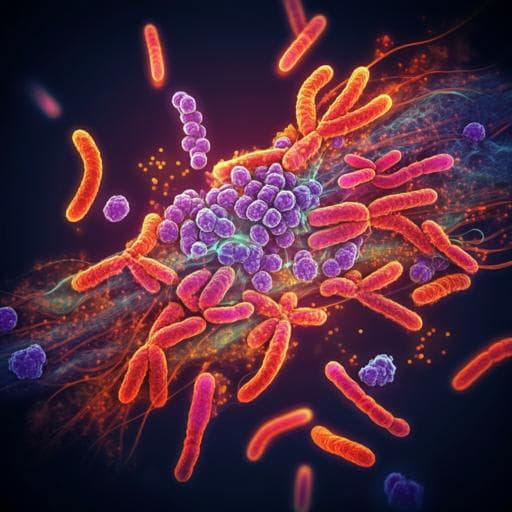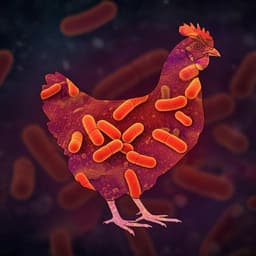
Agriculture
Production of synthetic wheat lines to exploit the genetic diversity of emmer wheat and D genome containing Aegilops species in wheat breeding
G. Mirzaghaderi, Z. Abdolmalaki, et al.
This research, conducted by Ghader Mirzaghaderi, Zinat Abdolmalaki, Rahman Ebrahimzadegan, Farshid Bahmani, Fatemeh Orooji, Mohammad Majdi, and Ali-Akbar Mozafari, reveals the creation of 192 cross combinations of diverse wheat and Aegilops genotypes, producing stable synthetic amphiploids. The findings highlight how emmer wheat and Aegilops species can enhance the genetic diversity of bread wheat, showcasing incredible potential for future agricultural enhancements.
~3 min • Beginner • English
Introduction
Bread wheat arose from hybridization between cultivated emmer (AABB) and Ae. tauschii (DD), but suffers from low genetic diversity due to its recent origin and subsequent domestication and selection. Emmer wheat and D-genome Aegilops species harbor valuable traits (e.g., disease resistance, abiotic stress tolerance, grain quality) that can broaden the wheat gene pool. Allopolyploid Aegilops species with D-genome components (e.g., Ae. crassa, Ae. cylindrica, Ae. ventricosa) are underutilized due to crossing barriers, genetic drag, and difficulty distinguishing alien from wheat D-genome segments. With improved genomic resources, more efficient introgression is feasible, but interspecific crosses often require embryo rescue. The study aimed to generate novel genetic resources by crossing diverse T. turgidum (subsp. dicoccum, dicoccoides, durum) and T. timopheevii with D-genome Aegilops (Ae. tauschii, Ae. crassa, Ae. cylindrica, Ae. ventricosa) to create synthetic hexa- and octaploid lines, assess crossability, cytogenetic stability, and phenotypic diversity, and provide materials for wheat improvement.
Literature Review
Background literature indicates: (1) the A and B genome progenitors of emmer wheat are Triticum urartu (AA) and a Sitopsis species, most likely Aegilops speltoides (SS); wild emmer formed ~0.36–0.5 Mya and cultivated emmer was domesticated ~10,000 years ago. (2) Bread wheat arose via hybridization of cultivated emmer with Ae. tauschii; its D subgenome remains similar to Ae. tauschii, facilitating introgression. (3) D-genome Aegilops species carry useful traits such as frost and salt tolerance, rust resistance, and nematode resistance; however, they are underexploited due to crossing barriers and genetic drag. (4) Crossability genes (e.g., Kr1, Kr2, Kr3, SKr) in wheat affect hybrid formation with Aegilops; crossability in tetraploid wheat may involve different chromosomes (e.g., 7A, 4B). (5) CIMMYT and others have produced many synthetic hexaploids via durum × Ae. tauschii, but emmer-based synthetics are less explored. These reports motivate the production and evaluation of new synthetic amphiploids using diverse A- and D-genome donors.
Methodology
Plant materials: 11 emmer landraces were collected in Kurdistan province (Iran), 12 emmer genotypes and common wheat cultivars obtained from SPII; T. timopheevii and some durum from ICARDA; additional durum and domesticated emmer from CIMMYT or DARI. Ae. tauschii, Ae. crassa, Ae. ventricosa accessions from IPK (Germany); some Ae. tauschii from SPII; Ae. crassa accessions 'Bookan' and 'Sanandaj', Ae. cylindrica '1' and '236', and wild emmer ecotypes 'Hawraman' and 'Seysaleh' collected in NW Iran. Crossing design: In field (University of Kurdistan farm) over 2017–2019, hand crosses were made: (i) tetraploid wheat (T. turgidum subsp. dicoccum, dicoccoides, durum) and T. timopheevii as female × Ae. tauschii (diploid DD or tetraploid DDDD) as male; (ii) tetraploid Aegilops (Ae. crassa, Ae. cylindrica, Ae. ventricosa) as female × tetraploid wheat as male. Crossing period May–June; daytime 18–37°C, night 5–17°C, low humidity; two outer florets pollinated; no hormones; spikes of wild emmer and tetraploid Aegilops bagged post-crossing. Embryo rescue: For shriveled F1 seeds (mostly from T. turgidum × Ae. tauschii), embryos were excised after surface sterilization (5% NaOCl, 15 min; rinses; overnight water at 4°C) and cultured on 1/2 MS medium (pH 5.8, with vitamins) under 16 h light/8 h dark at 22–24°C; seedlings (~10 cm) were transplanted to soil and then field. No chemical chromosome doubling; F2 seed production relied on spontaneous formation of unreduced gametes and selfing. F1 seeds from tetraploid Aegilops × wheat possessed endosperm and did not require embryo rescue. Hybrid verification: In spring, non-hybrids were rogued based on morphology; F1 spikes were bagged for selfing. Pollen viability: Alexander’s stain used; 10 immature anthers per cross type (from four spikelets, different tillers) scored; strongly stained swollen pollen considered viable. Cytogenetics: FISH on root tips using pTa535-1 (TAMRA-labeled) and (GAA)10 (FAM-labeled) oligos; standard pretreatments, hybridization, washes; DAPI counterstain; Olympus BX51 microscope imaging. Chromosome identification followed published karyotypes for T. timopheevii, Ae. crassa, and Ae. cylindrica; C-banding performed per Gill et al. Morphology and grain micronutrients: Amphiploids grown in rows (5 m, 0.5 m spacing; 20 seeds/row), rain + irrigation, no fertilizer. Nine plants per line measured: plant height, spike length, awn length, spikelets/spike, node number, flag leaf width/length, flowering time, peduncle length. Fe and Zn quantified by acid digestion (HNO3:HCl 2:1) and atomic absorption; three biological replicates; reported in µg/g DW. Statistics: Crossability = F1 embryos or seeds / pollinated florets; bar plots in R 3.6.1. Pollen viability analyzed by CRD ANOVA on log-transformed data; Pearson correlation between viable/unreduced gamete rates and seed set. PCA on morphological traits.
Key Findings
- Cross program: 192 cross combinations performed across six cross types over three years. 56 synthetic F2 lines recovered spanning genomes AABBDD, AABBDDDD, AAGGDD, D'D'XX AABB, D'D'C°C° AABB, and D'D'N'N AABB. - Tetraploid wheat × Ae. tauschii and T. timopheevii × Ae. tauschii: • 101 T. turgidum × Ae. tauschii and 4 T. timopheevii × Ae. tauschii combinations. Mean crossability for T. turgidum × Ae. tauschii was 0.062 (range 0–0.38). Ae. tauschii 'AE 1211' and 'G 299' showed the highest mean crossability (0.15 and 0.08). • From 101 T. turgidum × Ae. tauschii combinations, 346 F1 seeds from 44 combinations; only 14 had endosperm and germinated autonomously; the remainder required embryo rescue. Of 90 shriveled F1 seeds tested, 52% (47/90) were successfully rescued to plants. F1 seeds from 25 combinations matured and produced amphiploid F2 seeds. • T. timopheevii showed average crossability 0.085 with Ae. tauschii, producing 167 thin but healthy, autonomously germinating F1 seeds from four combinations. • In total, 29 distinct synthetic hexaploid/octaploid F2 lines with AABBDD, AABBDDDD, or AAGGDD were obtained from these crosses. - Tetraploid Aegilops × tetraploid wheat: • 87 cross combinations using Ae. crassa, Ae. cylindrica, Ae. ventricosa (as females). Overall mean crossability 0.51; means by species: Ae. crassa 0.52, Ae. cylindrica 0.49, Ae. ventricosa 0.43. • Produced 1322 F1 seeds; in a sample of 50 F1 seeds, 28 germinated (0.56), and 74% of these grew to maturity. • 262 octaploid F2 seeds recovered from 27 combinations, generating amphiploids with D'D'XXAABB, D'D'C'C'AABB, and D'D'N'N'AABB genomes. - Pollen viability and seed set: • Pollen viability varied widely among hybrids. For T. turgidum × Ae. tauschii, viable pollen means were 0.86%, 24.81%, 12.10%, and 9.14% across four hybrids. For Ae. crassa × T. turgidum, means ranged 0.39% to 17.33% depending on genotype. T. durum '17' × Ae. cylindrica '236' showed 0% viable pollen. Ae. ventricosa 'AE 1522' × T. durum '11' had mean unreduced gametes 1.02%. • Unreduced gamete rates correlated with plump seed set (r = 0.75, P = 0.005), indicating F2 seed formation largely via unreduced gametes. - Cytogenetics (FISH/C-banding): • Ae. tauschii 'AE 1211' was revealed as autotetraploid (2n = 4x = 28). • T. timopheevii '131212' carried a balanced reciprocal translocation between 5A' and 6G (5A'S.6GL and 6GS.5A'L), also detected in its amphiploid with Ae. tauschii 'AE 1602'. • Detected a small heterozygous deletion at distal 1BL in T. durum '78' × Ae. tauschii '191' F2; an Ae. cylindrica '236' × T. durum '17' amphiploid was monosomic (2n = 55) with a rearranged 2C. • Ae. crassa × T. turgidum amphiploids examined were complete disomics (2n = 56), suggesting higher cytogenetic stability than Ae. cylindrica- and Ae. ventricosa-derived amphiploids, where aneuploidy (2n = 54, 53) was observed. - Phenotypic diversity: • Parents and amphiploids showed wide variation in morphology. Emmer parents displayed wide ranges for flag leaf width (5.6–19.6 mm), spikelets/spike (10.3–29.6), spike length (6.1–13.6 cm), flowering time (44–93 days from spring start), and grain Fe (24.2–66.3 µg/g DW) and Zn (16–62.3 µg/g DW). • Amphiploids also varied substantially; PCA grouped amphiploids by genome composition, with higher dispersion for Ae. crassa-wheat amphiploids. Lines with high grain micronutrients included Ae. cylindrica '1' × T. durum '17', Ae. ventricosa '1522' × T. durum '8', and Ae. crassa 'Sanandaj' × T. durum '6268'.
Discussion
The study demonstrates that combining diverse emmer/durum/T. timopheevii genotypes with D-genome Aegilops effectively generates synthetic hexa- and octaploid wheat lines that broaden genetic variation available to bread wheat. Despite low to moderate crossability in T. turgidum × Ae. tauschii crosses and frequent need for embryo rescue, substantial numbers of F1 and F2 lines were recovered, aided by the formation of unreduced gametes. Tetraploid Aegilops × tetraploid wheat crosses showed higher crossability and endosperm development, facilitating amphiploid production. Cytogenetic analyses indicated generally good stability, especially in Ae. crassa-derived amphiploids, while some aneuploidy and minor rearrangements occurred in Ae. cylindrica- and Ae. ventricosa-derived lines, consistent with meiotic irregularities in novel polyploids. The discovery of an autotetraploid Ae. tauschii accession (AE 1211) and detection of specific translocations (5A'/6G in T. timopheevii) provide additional resources and considerations for breeding. The broad morphological and grain micronutrient diversity observed suggests practical potential for improving agronomic traits, stress resistances, and nutritional quality. These synthetic lines and amphiploids can serve as bridges to introgress favorable alleles into bread wheat, with marker-assisted selection enabling targeted retention of recombinant D-genome segments.
Conclusion
A comprehensive crossing program between tetraploid Triticum (emmer, durum, T. timopheevii) and D-genome Aegilops (Ae. tauschii, Ae. crassa, Ae. cylindrica, Ae. ventricosa) produced 56 synthetic F2 lines encompassing AABBDD, AABBDDDD, AAGGDD, D'D'XXAABB, D'D'C'C'AABB, and D'D'N'N'AABB genomes. Embryo rescue and spontaneous unreduced gamete formation enabled line recovery without chemical doubling. Cytogenetic analyses showed overall promising genomic stability, particularly in Ae. crassa-derived amphiploids, with some aneuploidy/rearrangements in others. The materials exhibit wide phenotypic and micronutrient diversity and represent valuable germplasm for expanding bread wheat genetic variation through crossing and backcrossing. Future work should focus on multi-generation cytogenomic tracking, stabilization, and targeted introgression into T. aestivum, supported by molecular markers for D-genome segment selection.
Limitations
- Many T. turgidum × Ae. tauschii crosses had low crossability and required embryo rescue; flowering time mismatches constrained specific genotype combinations. - Several amphiploids, particularly Ae. cylindrica- and Ae. ventricosa-derived, showed aneuploidy and potential instability; the long-term genomic stability of auto-allo-octaploids (AABBDDDD) may be affected by their cytogenetic constitution. - Cytogenetic assessments were conducted on limited numbers of seeds/individuals per cross, so rare rearrangements or chromosome eliminations may be underdetected. - The mechanism of F2 formation relied on unreduced gametes; rates are genotype- and direction-dependent, potentially limiting scalability. - Environmental testing was limited to a single site and seasons; agronomic performance and trait expression under diverse environments remain to be validated. - Additional genomic analyses across generations are needed to monitor rearrangements and ensure stable transmission of alien chromatin.
Related Publications
Explore these studies to deepen your understanding of the subject.







